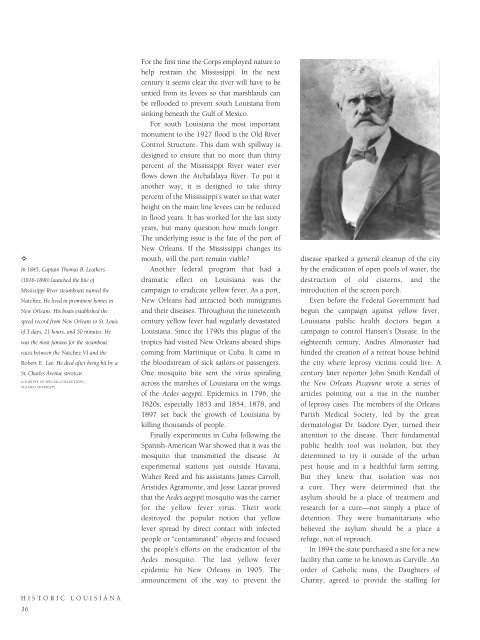Historic Louisiana
An illustrated history of Louisiana, paired with the histories of companies, families and organizations that make the state great.
An illustrated history of Louisiana, paired with the histories of companies, families and organizations that make the state great.
You also want an ePaper? Increase the reach of your titles
YUMPU automatically turns print PDFs into web optimized ePapers that Google loves.
✧<br />
In 1845, Captain Thomas B. Leathers<br />
(1816-1896) launched the line of<br />
Mississippi River steamboats named the<br />
Natchez. He lived in prominent homes in<br />
New Orleans. His boats established the<br />
speed record from New Orleans to St. Louis<br />
of 3 days, 21 hours, and 50 minutes. He<br />
was the most famous for the steamboat<br />
races between the Natchez VI and the<br />
Robert E. Lee. He died after being hit by a<br />
St. Charles Avenue streetcar.<br />
COURTESY OF SPECIAL COLLECTIONS,<br />
TULANE UNIVERSITY.<br />
HISTORIC LOUISIANA<br />
36<br />
For the first time the Corps employed nature to<br />
help restrain the Mississippi. In the next<br />
century it seems clear the river will have to be<br />
untied from its levees so that marshlands can<br />
be reflooded to prevent south <strong>Louisiana</strong> from<br />
sinking beneath the Gulf of Mexico.<br />
For south <strong>Louisiana</strong> the most important<br />
monument to the 1927 flood is the Old River<br />
Control Structure. This dam with spillway is<br />
designed to ensure that no more than thirty<br />
percent of the Mississippi River water ever<br />
flows down the Atchafalaya River. To put it<br />
another way, it is designed to take thirty<br />
percent of the Mississippi’s water so that water<br />
height on the main line levees can be reduced<br />
in flood years. It has worked for the last sixty<br />
years, but many question how much longer.<br />
The underlying issue is the fate of the port of<br />
New Orleans. If the Mississippi changes its<br />
mouth, will the port remain viable?<br />
Another federal program that had a<br />
dramatic effect on <strong>Louisiana</strong> was the<br />
campaign to eradicate yellow fever. As a port,<br />
New Orleans had attracted both immigrants<br />
and their diseases. Throughout the nineteenth<br />
century yellow fever had regularly devastated<br />
<strong>Louisiana</strong>. Since the 1790s this plague of the<br />
tropics had visited New Orleans aboard ships<br />
coming from Martinique or Cuba. It came in<br />
the bloodstream of sick sailors or passengers.<br />
One mosquito bite sent the virus spiraling<br />
across the marshes of <strong>Louisiana</strong> on the wings<br />
of the Aedes aegypti. Epidemics in 1796, the<br />
1820s, especially 1853 and 1854, 1878, and<br />
1897 set back the growth of <strong>Louisiana</strong> by<br />
killing thousands of people.<br />
Finally experiments in Cuba following the<br />
Spanish-American War showed that it was the<br />
mosquito that transmitted the disease. At<br />
experimental stations just outside Havana,<br />
Walter Reed and his assistants James Carroll,<br />
Aristides Agramonte, and Jesse Lazear proved<br />
that the Aedes aegypti mosquito was the carrier<br />
for the yellow fever virus. Their work<br />
destroyed the popular notion that yellow<br />
fever spread by direct contact with infected<br />
people or “contaminated” objects and focused<br />
the people’s efforts on the eradication of the<br />
Aedes mosquito. The last yellow fever<br />
epidemic hit New Orleans in 1905. The<br />
announcement of the way to prevent the<br />
disease sparked a general cleanup of the city<br />
by the eradication of open pools of water, the<br />
destruction of old cisterns, and the<br />
introduction of the screen porch.<br />
Even before the Federal Government had<br />
begun the campaign against yellow fever,<br />
<strong>Louisiana</strong> public health doctors began a<br />
campaign to control Hansen’s Disease. In the<br />
eighteenth century, Andres Almonaster had<br />
funded the creation of a retreat house behind<br />
the city where leprosy victims could live. A<br />
century later reporter John Smith Kendall of<br />
the New Orleans Picayune wrote a series of<br />
articles pointing out a rise in the number<br />
of leprosy cases. The members of the Orleans<br />
Parish Medical Society, led by the great<br />
dermatologist Dr. Isadore Dyer, turned their<br />
attention to the disease. Their fundamental<br />
public health tool was isolation, but they<br />
determined to try it outside of the urban<br />
pest house and in a healthful farm setting.<br />
But they knew that isolation was not<br />
a cure. They were determined that the<br />
asylum should be a place of treatment and<br />
research for a cure—not simply a place of<br />
detention. They were humanitarians who<br />
believed the asylum should be a place a<br />
refuge, not of reproach.<br />
In 1894 the state purchased a site for a new<br />
facility that came to be known as Carville. An<br />
order of Catholic nuns, the Daughters of<br />
Charity, agreed to provide the staffing for
















